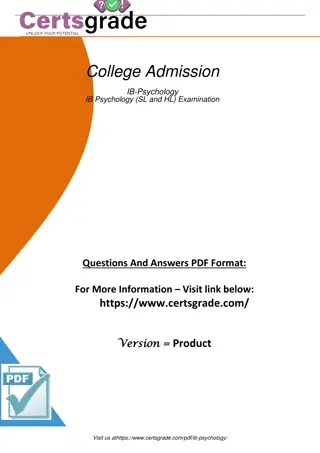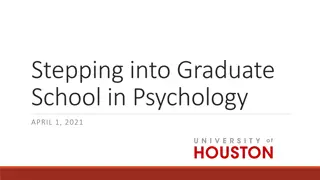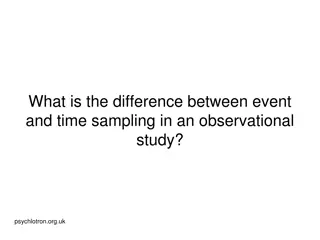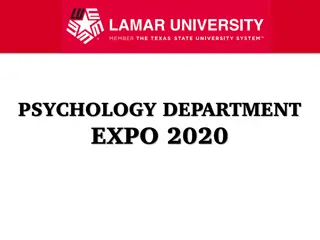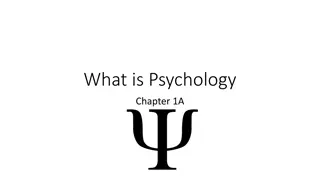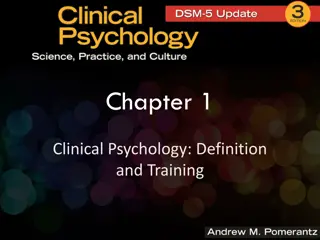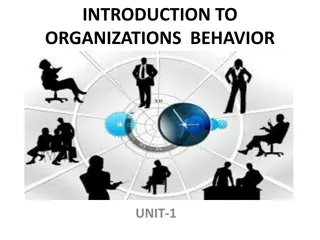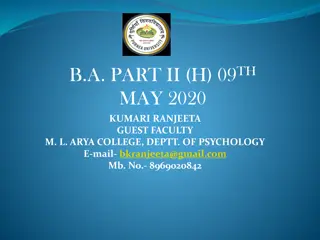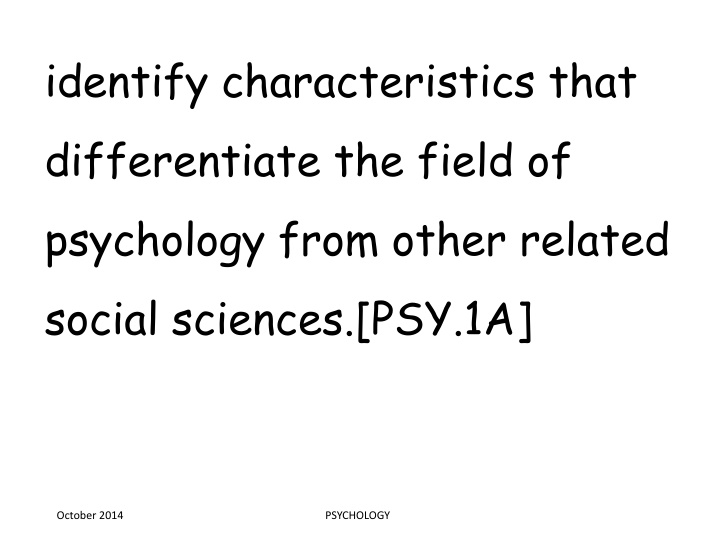
Distinguishing Psychology from Related Social Sciences: Insights and Perspectives
Explore the unique characteristics of psychology compared to other social sciences, delve into the historical evolution of psychological perspectives, uncover diverse subfields and career paths in psychology, differentiate theory and principle concepts, understand ethical data practices, interpret statistical measures, anatomical insights on nervous and endocrine systems, and their impact on development and behavior, and discuss sensory system capabilities and limitations.
Download Presentation

Please find below an Image/Link to download the presentation.
The content on the website is provided AS IS for your information and personal use only. It may not be sold, licensed, or shared on other websites without obtaining consent from the author. If you encounter any issues during the download, it is possible that the publisher has removed the file from their server.
You are allowed to download the files provided on this website for personal or commercial use, subject to the condition that they are used lawfully. All files are the property of their respective owners.
The content on the website is provided AS IS for your information and personal use only. It may not be sold, licensed, or shared on other websites without obtaining consent from the author.
E N D
Presentation Transcript
identify characteristics that differentiate the field of psychology from other related social sciences.[PSY.1A] October 2014 PSYCHOLOGY
trace the historical development of the contemporary perspectives in psychology, including biological, behavioral, cognitive, sociocultural, humanistic, and psychodynamic.[PSY.1B] October 2014 PSYCHOLOGY
explore subfields and career opportunities available in the science of psychology.[PSY.1C] October 2014 PSYCHOLOGY
define and differentiate the concepts of theory and principle.[PSY.2A] October 2014 PSYCHOLOGY
identify and describe the basic methods of social scientific reasoning.[PSY.2B] October 2014 PSYCHOLOGY
apply the standards of the American Psychological Association (APA) for ethical decision making regarding the collection, storage, and use of psychological data.[PSY.2C] October 2014 PSYCHOLOGY
define and interpret measures of central tendency (mean, median, and mode) and dispersion (range and standard deviation).[PSY.2D] October 2014 PSYCHOLOGY
describe the anatomy of the central and peripheral nervous systems and the endocrine system.[PSY.3A] October 2014 PSYCHOLOGY
explain the effects of the endocrine and nervous systems on development and behavior.[PSY.3B] October 2014 PSYCHOLOGY
explain the capabilities and limitations of sensory systems and individual perceptions.[PSY.4A] October 2014 PSYCHOLOGY
understand the interaction of the individual and the environment in determining sensation and perception.[PSY.4B] October 2014 PSYCHOLOGY
critique the various perspectives presented in the nature versus nurture debate.[PSY.5A] October 2014 PSYCHOLOGY
trace the influence of physical development on the individual.[PSY.5B] October 2014 PSYCHOLOGY
discuss the role of the caregiver on individual development.[PSY.5C] October 2014 PSYCHOLOGY
explain factors involved in cognitive development according to Jean Piaget.[PSY.5D] October 2014 PSYCHOLOGY
describe Erik Erikson's stages of psychosocial development.[PSY.5E] October 2014 PSYCHOLOGY
evaluate the predicted outcomes of given courses of actions in particular situations based on an understanding of the development of morality.[PSY.5F] October 2014 PSYCHOLOGY
evaluate the presented theories of human development and specify the strengths and weaknesses of each.[PSY.5G] October 2014 PSYCHOLOGY
demonstrate an understanding of the principles of operant and classical conditioning and of social learning.[PSY.6A] October 2014 PSYCHOLOGY
describe the processes of learning using typical classroom situations.[PSY.6B] October 2014 PSYCHOLOGY
compare predominant theories of motivation and emotion.[PSY.7A] October 2014 PSYCHOLOGY
explore the interaction of biological and cultural factors in emotion and motivation.[PSY.7B] October 2014 PSYCHOLOGY
differentiate the various types of intelligence.[PSY.8A] October 2014 PSYCHOLOGY
describe statistical concepts used in testing.[PSY.9A] October 2014 PSYCHOLOGY
differentiate among aptitude, achievement, and Intelligence Quotient (IQ) tests.[PSY.9B] October 2014 PSYCHOLOGY
define personality.[PSY.10A] October 2014 PSYCHOLOGY
compare and evaluate various theories of personality, including psychodynamic, trait, humanistic, and sociocultural.[PSY.10B] October 2014 PSYCHOLOGY
describe personality assessment tools.[PSY.10C] October 2014 PSYCHOLOGY
define and identify the basic elements of thought.[PSY.11A] October 2014 PSYCHOLOGY
identify strategies and obstacles associated with problem solving and decision making.[PSY.11B] October 2014 PSYCHOLOGY
explore the structural features of language.[PSY.11C] October 2014 PSYCHOLOGY
discuss theories of language acquisition and development.[PSY.11D] October 2014 PSYCHOLOGY
evaluate the limitations and capabilities of the information processing model.[PSY.11E] October 2014 PSYCHOLOGY
understand the states and levels of consciousness.[PSY.11F] October 2014 PSYCHOLOGY
explain stress and the individual's physiological, behavioral, and psychological responses to stressors.[PSY.12A] October 2014 PSYCHOLOGY
evaluate cognitive and behavioral strategies for dealing with stress.[PSY.12B] October 2014 PSYCHOLOGY
analyze the challenges inherent in defining abnormal behavior and acknowledge the sociocultural stigma of labeling behavior as abnormal.[PSY.12C] October 2014 PSYCHOLOGY
recognize the biological, social, and cognitive origins of abnormal behavior.[PSY.12D] October 2014 PSYCHOLOGY
iscuss major categories of abnormal behaviors and identify their respective characteristics as classified in the Diagnostic and Statistical Manual (DSM).[PSY.12E] October 2014 PSYCHOLOGY
evaluate the effectiveness of past and present methods of therapy.[PSY.12F] October 2014 PSYCHOLOGY
describe how attributions affect explanations of behavior.[PSY.13A] October 2014 PSYCHOLOGY
explore the nature and effects of bias and discrimination.[PSY.13B] October 2014 PSYCHOLOGY
describe circumstances in which conformity and obedience are likely to occur.[PSY.13C] October 2014 PSYCHOLOGY
describe the effects of the presence of others on individual behavior.[PSY.13D] October 2014 PSYCHOLOGY
discuss the nature of altruism.[PSY.13E] October 2014 PSYCHOLOGY
discuss the factors influencing attraction.[PSY.13F] October 2014 PSYCHOLOGY
identify sources of attitude formation and assess methods used to influence attitudes.[PSY.13G] October 2014 PSYCHOLOGY
analyze examples of attitudes, beliefs, and behaviors related to changes in available technology.[PSY.18A] October 2014 PSYCHOLOGY
evaluate the impact of changes in technology on personal growth and development.[PSY.18B] October 2014 PSYCHOLOGY


